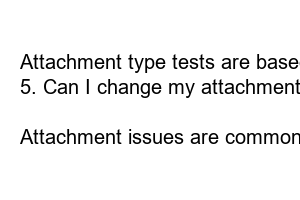애착유형 테스트
Title: Discover Your Attachment Type with This Test
Are you curious about your attachment style and how it may impact your relationships? The Attachment Type Test is a quick and easy way to gain insight into how you relate to others. Taking this test can help you better understand your own behaviors and preferences when it comes to forming close connections with others.
**What Is an Attachment Type Test?**
The Attachment Type Test is a simple assessment designed to determine your attachment style, which is the way you interact with others in relationships. By answering a series of questions about your thoughts, feelings, and behaviors in relationships, you can discover whether you have a secure, anxious, dismissive-avoidant, or fearful-avoidant attachment style.
**Why is it Important to Know Your Attachment Type?**
Understanding your attachment style can provide valuable insight into the way you approach relationships. It can help you recognize patterns in your behavior and identify areas for growth and improvement. By knowing your attachment type, you can work towards building healthier, more fulfilling relationships with others.
**How to Take an Attachment Type Test**
To take an Attachment Type Test, simply find a reputable online assessment tool and answer the questions honestly. Results are typically provided instantly, along with a description of your attachment style and what it means for your relationships. You can use this information to make positive changes in your interactions with others.
**Types of Attachment Styles**
There are four main attachment styles: secure, anxious, dismissive-avoidant, and fearful-avoidant. Each style comes with its own set of characteristics and behaviors that influence how you interact with others. Understanding your attachment style can help you navigate relationships more effectively.
**Tips for Building Secure Attachments**
Regardless of your attachment style, you can work towards building healthier, more secure attachments with others. This can involve practicing effective communication, setting boundaries, and seeking support when needed. By prioritizing your emotional well-being and investing in your relationships, you can cultivate greater security in your connections with others.
**Summary**
The Attachment Type Test is a valuable tool for gaining insight into your attachment style and how it influences your relationships. By understanding your attachment type, you can make positive changes in the way you interact with others and build more secure connections. Take the test today to start your journey towards healthier, more fulfilling relationships.
**FAQs**
1. What if my attachment style changes over time?
Attachment styles can evolve and change with personal growth and experiences. It’s important to regularly assess your attachment type and seek support if needed.
2. Can I have a combination of attachment styles?
While most people display a dominant attachment style, it is possible to exhibit traits of multiple attachment styles. This can be a complex but normal part of human behavior.
3. How can therapy help with attachment issues?
Therapy can provide a safe space to explore and understand your attachment style, as well as develop healthier relationship patterns. A trained professional can offer guidance and support in navigating attachment issues.
4. Are attachment type tests accurate?
Attachment type tests are based on research-backed theories and can provide valuable insights into your relational tendencies. While they may not be 100% accurate, they offer a helpful starting point for self-reflection and growth.
5. Can I change my attachment style?
With self-awareness, effort, and support, it is possible to shift towards a more secure attachment style. Therapy, mindfulness practices, and healthy communication techniques can all contribute to positive changes in attachment patterns.
6. Is it normal to have attachment issues?
Attachment issues are common and can stem from early childhood experiences, trauma, or patterns learned in past relationships. Seeking support and working towards understanding and addressing these issues is a healthy step towards healing and growth.

